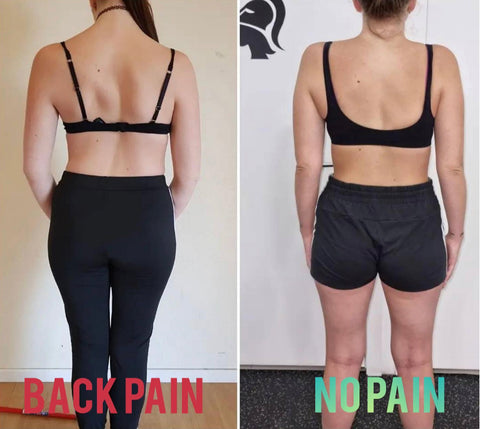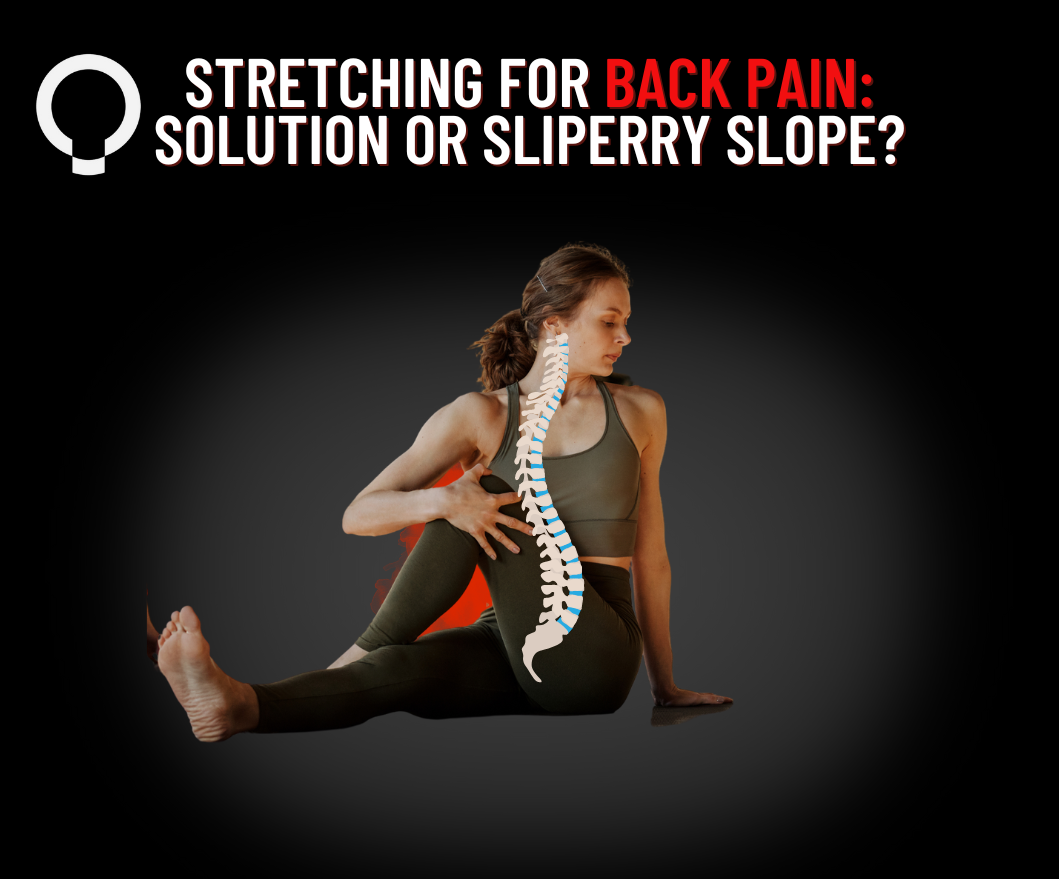
Can back pain be addressed with stretching?
It seems moving with an upright spine may not be so simple considering the prevalence of back pain many humans experience after standing, walking, or even sitting for prolonged periods of time. Statistics say that as many as 8 in 10 adults will experience back pain in their lifetime. At Functional Patterns, we aim to address this unfortunate circumstance many face by educating you on how your body can move more efficiently by improving your posture and eliminating unnecessary joint strain.

Before we discuss more of the solution, first let us set the framework for where we operate from as humans. We will then analyze a common approach many use in an attempt to find a fix for acute or chronic back pain relief. Is stretching for upper or lower back pain the best treatment out there? After, we’ll discuss the possible detrimental effects of stretching, before finally revealing what the recommended alternative is.
Environment
Regardless of whether or not someone believes in evolution, humans and animals face the same physical forces, like gravity and inertia, when walking and doing daily tasks. While we do use other modes of transportation, one of the most prevalent and important forms of moving for humans is walking. Although the forces we face are the same, there are many ways we have altered our daily movement as we have reduced our need to hunt and gather resources into creating specialized jobs over time. This shift from having to run and throw in order to survive may have led us to see more of our population overweight with limited core function and increased levels of back pain in our society. The muscles of the abdomen are the counterpart to our back and need proper ratios of tension to help align our back properly to avoid pain, more on that in a bit.
In nature most animals seem capable of resting with little to no effort when they are not forced to work in the form of searching for food or water. You may even notice this with some dogs if they are sleeping and can become awakened and alert in moments when something startles them, however once they realize there is no threat, they almost immediately go back to sleep with no issue. This seems to be related to the way they respond to stress. In his book "Why Zebras Don't Get Ulcers", Robert Sapolsky describes how animals can use shaking or trembling to release the tension that builds up in their bodies as a response to stress. This process, known as neurogenic tremors or therapeutic tremors, allows animals to discharge the excess energy that accumulates during a stressful event and return to a state of relaxation.
Humans for the most part seem to have lost this more intuitive sense to relieving stress through physical means as we began to rely less and less on our physical capabilities to survive as time progressed. In the book “Sapiens: A Brief History of Humankind,” Yuval Noah Harari describes, as we began relying more on agriculture and repetitive tool use for farming the prevalence of scoliosis, slipped discs, and hernias also increased in the human fossil record. These imbalances were likely passed on over generations and enhanced as we became more sedentary over time. At Functional Patterns we ask, is it possible that we as humans should not need to undergo the extra maintenance of stretching for stiffness or pain if we are able to regain more precise motion as animals have and humans likely had?

Potential for Damage
Whether it’s sharp and acute back pain, or you’ve been in the market for a chronic back pain treatment for a while, it’s frustrating to deal with. Stretching may seem like an intuitive answer for some. After all, the associated feeling of back pain, whether it be lower, middle, or upper, is a usually sense of “tightness”. Therefore, it’s fair to come to the conclusion that in order to address this tightness, you need to make space. Stretching claims to create this space.
Stretching is popular due to its accessibility, apparent simplicity, and nearly immediate outcomes. But let’s examine those stretching treatment options. There’s specific techniques for areas such as stretches for mid back pain, in which case it’s recommended to do a seated twist (sitting down while pulling yourself side to side) or a yoga favorite, the child’s pose (kneeling facedown on the floor while leaning your torso forward and reaching your arms forward). How do these stretches address mid back pain? Many will claim they increase range of motion or elongate the spine, but we find those to be very loose claims.
If we examine more closely these chronic back pain treatments, we’ll find they are more so a tool to mitigate pain which is a symptom, but they aren’t exactly upholding lasting relief because they aren’t addressing the root. In concept, these are decent tools. But in application, there are many variables that are unaccounted for with these treatments. Statically stretching your mid back, or any part of your back, has not been shown to improve the quality of movement, which is typically where pain and injury are experienced. Do you want a short-term, symptom-based treatment for chronic pain in the back, or do you want a long-term, root cause-focused solution?
According to a systematic review of the efficacy of stretching, from Research in Sports Medicine (2008), there is strong evidence to suggest that static stretching in particular does not reduce overall injury rates towards follow up physical activity and even the routines of every day life.
When we examine the way our body is able to stand upright more closely, we can see there are many muscles that rely on very specific length and tension relationships in order to avoid excessive compression in one joint or another.
Our body structurally is a tensegrity. This means there are parts of our body which use compression (bones) and other parts which use tension (muscles and ligaments) in order to allow us to stand or walk and avoid bone on bone contact in most of our body. Another tensegrity structure you may be familiar with is a suspension bridge.

In this structure the steel columns and concrete operate under compression while the cables and steel beneath the road use tension to suspend the bridge above the water. Let's imagine for a moment if all the cables on the left side of the bridge were somehow all 1 meter shorter than the cables on the right. What do you think would happen to the integrity of the bridge?
Intuitively you may begin to picture some form of damage or excess wear on the shorter cables as the other side would have slack and the brunt of the load would be bore on the left. We might also see the bridge begin favoring a sway to the left leading to uneven compression on the columns and potentially cause these structures to maladapt as well.
Just as there must be balance from the cables left to right across the length of the bridge for this structure to be stable, our bodies also require a balance of muscular tension from left to right as well as front to back to avoid unnecessary wear on our joints.
Many humans regrettably have distended abdomens due to bloating or being overweight and this can cause the lower back to compress by overly lengthening the muscles in the core on the front and sides of the body.
This will have downstream effects of causing certain muscles to shorten while others will prefer to maintain a lengthened state. As these constant tensions are placed on the body it can be very easy for certain muscles to feel overly worked since the load is no longer dispersed across the rest of our muscles in a way that is more balanced.
The Alternative
Stretches for back pain will likely not address the underlying issue if the lack of muscular tension in other areas of the body are not addressed. Using back stretching exercises may lead to further lack of muscular support and keep you in a cycle of stretching, then feeling stiff and repeating until the stretching no longer feels like it helps. The spine has many muscles that connect to it enabling it to shear, rotate, flex and extend to various degrees in nearly all planes of motion. At Functional Patterns we aim to break the cycle of band-aid approaches by teaching you how to precisely position your body so that you do not overly stretch muscles or overly compress joints that often lead people to experience pain in the first place.
If you would like to learn more about how to relieve back pain without medicine or stretching, it would be wise to reach out to one of our certified practitioners listed here on our website to get an in depth look at your posture and learn how to begin training in a way to promote balance in your body.
References:
“Why Zebras Don’t Get Ulcers” By Robert Sapolsky
“Sapiens: A Brief History of Humankind” By Yuval Noah Harari







